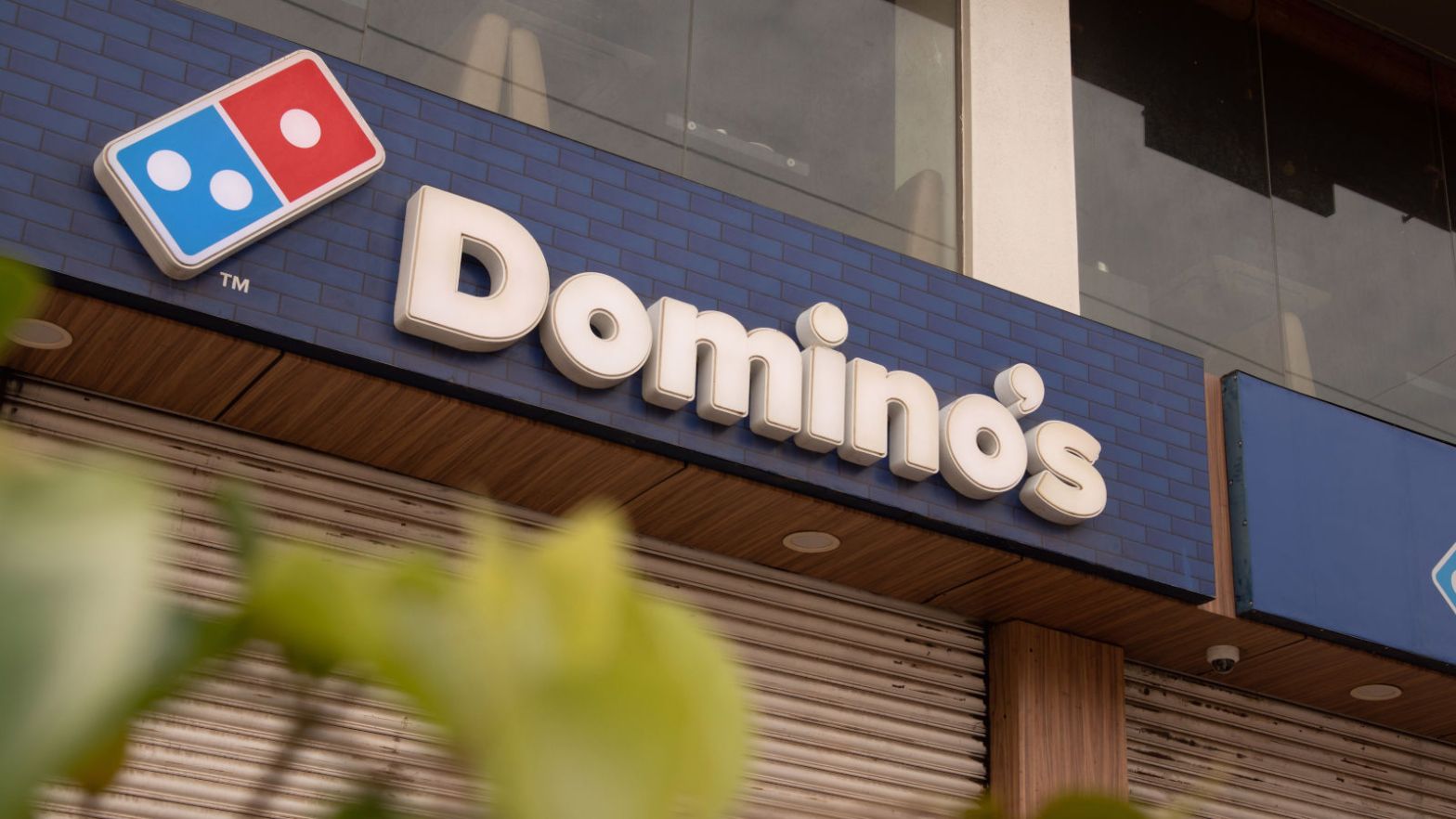Started in 1995, Domino’s has gone on to become the market leader in selling pizzas in India while making it the second largest market for the company outside the US
Let’s look at how Domino’s became India’s favourite pizza maker
Pizza is a snack
Domino’s has always operated in India under Jubilant FoodWorks (Earlier known as Domino’s Pizza India). This company holds exclusive rights to run Domino’s pizza chain in India and a few other south Asian countries. The company launched their first store in 1996 in New Delhi and the business went well initially but it found difficult to expand. People in India thought pizza is a snack and something that you would eat once in a while when sitting in a fancy restaurant
Jubilant realised they needed to do something radically different to grow big and expand beyond metro cities in India
The Consistent Compounder
Jubilant Foodworks has been one of the best wealth creator in the past couple decade and this section will tell you all about it
Below chart shows the stock price of Jubilant Foodworks over the years

The company went public in 2010 with IPO price of Rs 145 and it currently trades at around Rs 2900 with all-time high of around Rs 3200. That’s 22x returns in 10 years meaning a CAGR of over 36%
Go on, open your bank statement and check how much you make on those Fixed Deposits J

The revenues have grown steadily over the past decade at a brisk 25% CAGR from Rs 400cr in 2010 to roughly Rs 4000cr in 2020. It is noteworthy that there has not been one year where revenues have declined and it shows the consistency and efficiency they have as a company
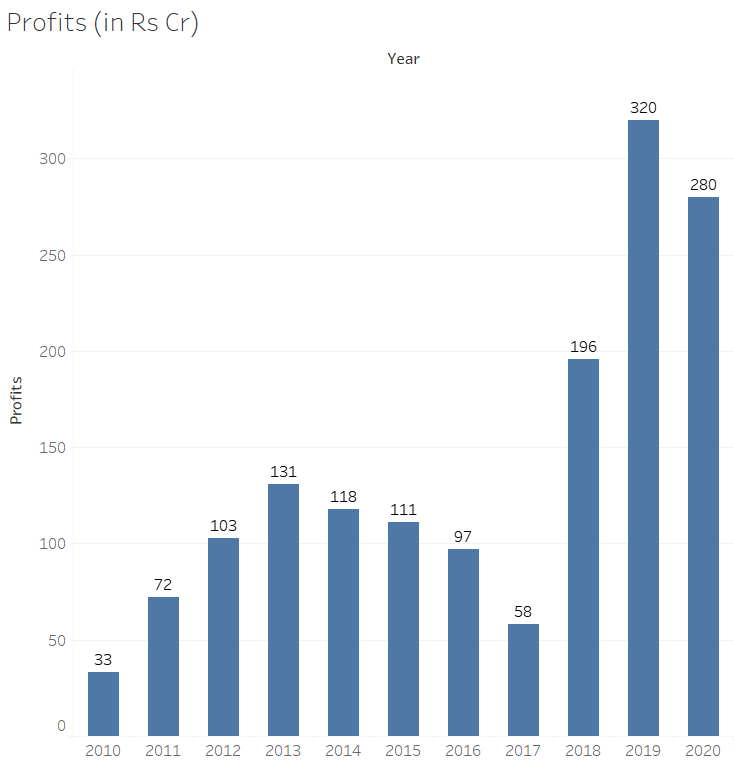
The profits have also increased from Rs 33cr in 2010 to Rs 280cr in 2020. The growth in profit was slow for the first half of the decade as most of it was reinvested in expansion plans but since then, the expansion has slowed down a little and profits have increased significantly
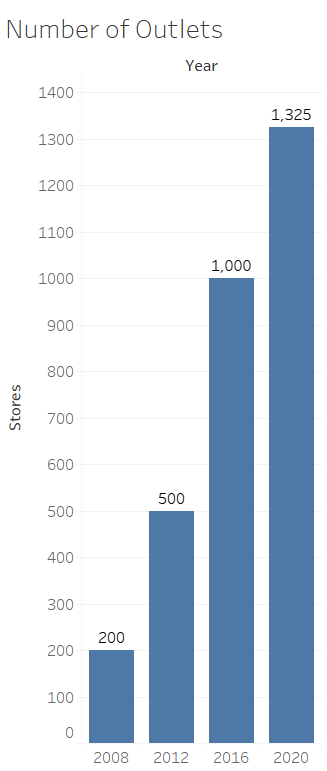
Now, the numbers above show why Domino’s is the largest QSR chain in India. It has 1300+ outlets spread over 280+ cities. This shows that the company has not only grown in metro cities but has also expanded its presence in tier 2 and tier 3 towns of the country. The above graph does not include outlets of other brands which Jubilant operates like Dunkin’s Donuts and Hong’s Kitchen
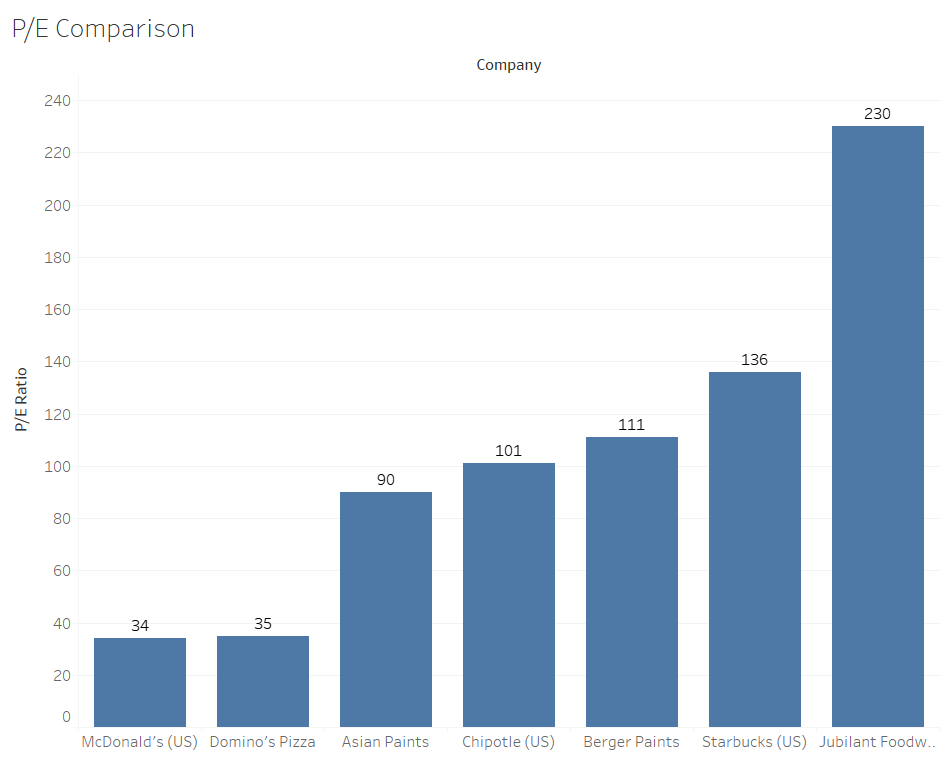
Now, the above figures do establish that Jubilant Foodworks is a high growth company and certainly dominates the QSR market in India. The thing with high growth companies is that they are expensive to own. Meaning that when stocks of these companies are listed, they trade at a premium compared to its peers
One metric which captures this is the P/E ratio or the price to earnings ratio. If the ratio is high it means that the price at which it is trading is much higher compared to its current earnings per share. This means that the company is capable of earning much more in future and hence the investors are paying a premium to buy the shares. In such case, the fundamental value of the company according to the investors is much higher than the current traded price
Have a look at the graph shown here, Jubilant Foodworks trades at a P/E ratio of 230. To give you a perspective, Asian Paints has grown at a CAGR of 20% for 5 decades and it trades at a P/E ratio of 90 while it is 111 of Berger Paints. The QSR chains listed in the US like McDonald’s and Domino’s itself trade at a much lower P/E of 34-35.
All this show that Jubilant in India has a much brighter future and it may continue to dominate the market unless something changes radically
But, what’s the benefit of going through these great numbers if you can’t figure out how Jubilant did all this?
Read on and I will tell you how it is done
India Positioning Strategy
As mentioned earlier, people considered Pizza as a snack and something that has to be ordered only occasionally. To change this mind-set, Domino’s came out with an innovative advertisement campaign in 2001. It was titled the “Hungry Kya?” campaign that went on to create a legacy and something which can be recalled even today
The advertisement tried to convey that people can order pizza whenever they are hungry irrespective of the situations. It was generally the younger generation that took the initiative of ordering food in those times and the same was being communicated through the TVC as well. Pizza can be a meal as well which the entire family can together enjoy
The campaign intended to transform occasional pizza ordering into a regular habit
30 Minute Delivery Challenge
We Indians love freebies, don’t we?
So in order to get people to at least try pizza, Domino’s launched 30 min delivery challenge. If your pizza was not delivered in 30 min, you don’t need to pay. This ensured that pizza was served hot for consumption
At the same time, they partnered with MTNL to receive orders through phone. One can dial a toll free number from anywhere in India and it will be routed to nearest Domino’s outlet.
This was coupled with a campaign featuring Paresh Rawal. The iconic advertisement can be found here
Tweaking the Offerings
The TVC campaign did wonders for Domino’s with people queuing up outside the outlets to get Pizza. The customer base grew among upper class and upper middle class. However, the middle class still stayed away from pizza ordering
The Indian consumers were a bit hesitant due to Domino’s pricing. The menu had a lot of imported dishes and was quite expensive at that time. Sensing this, Domino’s launched the Fun Meal pizza range at Rs 45 in 2006 and then the Pizza Mania range in 2008 at Rs 35.
After this, they customized the menu according to Indian tastes by adding Onion pizzas, Peppy Paneer and Pizza keema do pyaaza. These changes brought Pizza closer to a meal in Indian households
All this coupled with a 30 min delivery challenge and convenience of ordering from home brought new customers to Domino’s and once they tried the Pizza, the taste and overall experience ensured that customers keep ordering it again and again
The Operational Supremacy
The 30 min delivery challenge could backfire if a lot of pizzas are to be given for free. Hence Domino’s needed to ensure they deliver almost all orders on time. They did it by establishing a standardised process to be followed once the order is received by the outlet
Dough Preparation and Toppings – 4 min, Baking – 6 min, Cutting and packing the pizza – 5 min. The outlets are placed strategically to ensure all the nearby geographies can be reached within 8 min. This still leaves 7 min extra with the rider in case there is some traffic or there is a difficulty in finding the address. More than 99% of the pizzas are delivered on time following this process
Also, the management monitors the percentage of orders that were delayed by each outlet. If the rate is high that means the current outlet has too many orders to handle and there is an opportunity to open another outlet in same geography
The 30 min challenge is the USP for Domino’s hence even the orders received Zomato/Swiggy are delivered by Dominos’ delivery partners
Building the Brand
Over a period of time, Domino’s has strongly positioned itself in India gaining at impressive 21% share in India’s QSR market. This compares with just over 4% for Pizza Hut and 11% for McDonald’s
In 2017, Domino’s became the first Food Service Company to provide online and mobile ordering PAN India. They partnered with IRCTC to deliver pizza on trains across 135 locations in India. They never claimed to make the best pizzas in the world, it is however convenience that drives the business for them
Domino’s has tried to stay connected with the consumers through innovative marketing campaigns

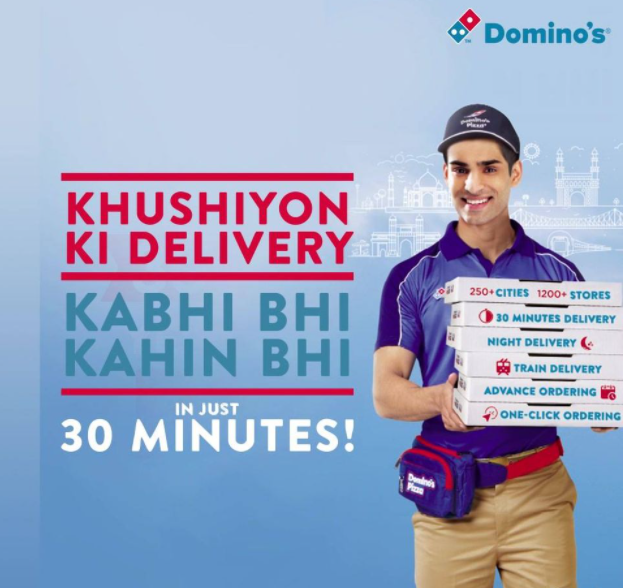
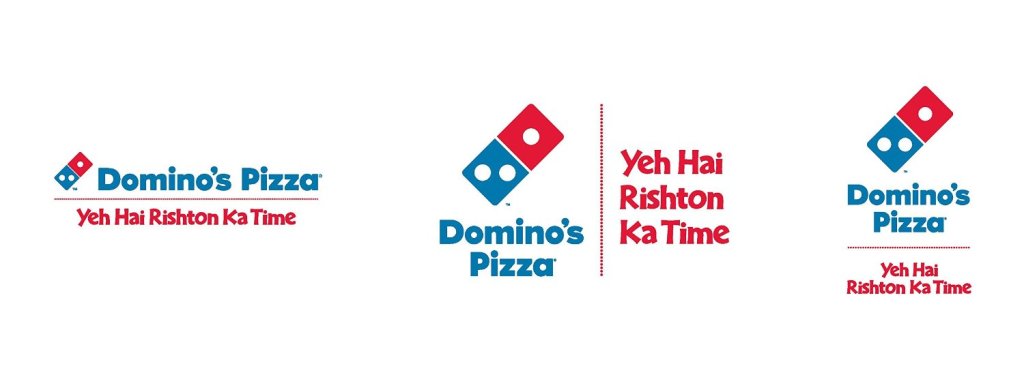
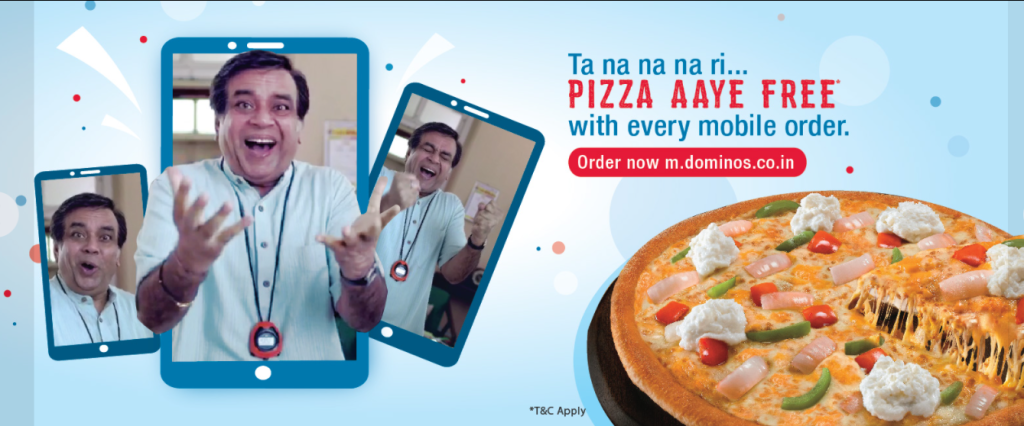
Beating the Pandemic
Food and Hospitality was the worst hit sector when the pandemic struck last year. The restaurants were closed and there were restrictions on going out. The April-June quarter was a complete washout for the entire industry
Domino’s knew that it will take some time to get dine-in customers back due to safety concerns and hence delivery was the only option to reach out to the customers. As things started opening up in July-Aug, they launched a digital campaign to communicate the safety measures undertaken by the staff in preparing and delivering the pizza
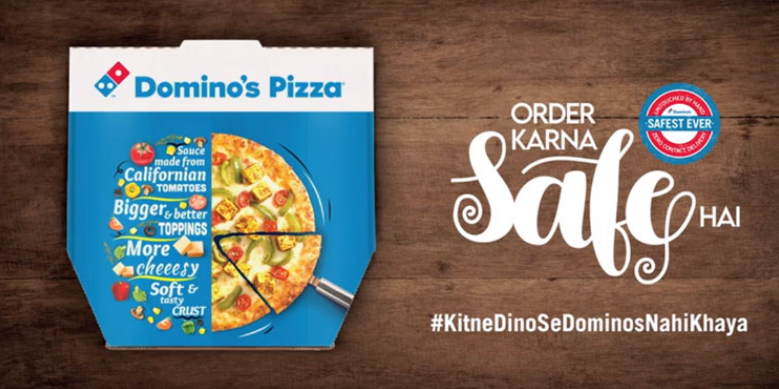
The campaign struck a chord with the customers and the orders started trickling in. Domino’s has always focussed on well-being of their staff and so while other chains were facing labour shortage, Domino’s started delivering swiftly
A lot of restaurants had to be closed down due to accumulated losses in the pandemic and this gave Domino’s an upper edge. They closed down few of the outlets in which dine-in did not contribute to major share in the business and also reduced the discounts. All this gave some cushioning to the balance sheet.
Pre pandemic, delivery used to contribute 60% to total business of Domino’s. Currently, it has crossed 70% with over 57 million downloads of its mobile app.
Newer Offerings
Domino’s contributes about 75% to Jubilant’s total sales and recently they have diversified themselves by coming up with new offerings
Jubilant also operates 27 outlets of Dunkin Donuts’ in 8 cities. This chain has been struggling for quite some time and has been mainly dependent on dine-in revenues
Seeing India’s love for Biryani, they have launched the brand names Ekdum! Which delivers hot biryani right to your doorstep. They have also opened 13 outlets for the brand Hong’s Kitchen in NCR bringing the Chinese cuisine closer to Indian households. With the brand Chefboss, Jubilant has ventured into ready to eat sauces and gravies.
Jubilant has mainly succeeded on the back of strong delivery DNA and brand recall for Domino’s. Whether they will be able to replicate the same with newer brands? Only time will tell
That’s it from my side today!
You can find my other posts by category here
Like my posts?? Do subscribe
If you do not have a WordPress account and are subscribing through email, you will receive a confirmation link in your mailbox. Click on the link to confirm subscription and receive regular updates
